by Judy Alter
When she reviewed Irene Deep in Texas Trouble, Kathleen Costa wrote, “Ok, I love Irene! I love the dynamic between the two women although it seems difficult to define. Are they friends? Colleagues? A Sherlock and Watson duo?” Costa’s review raised some questions I, as author, hadn’t thought about, though I sometimes struggled with the relationship between the two women. Irene is the diva and faux French chef of the title; Henny, host of a culinary TV show in Chicago and once Irene’s gofer, narrates the four books in the series. I had been billing these Irene in Chicago Culinary Mysteries as all about love and romance—and murder. The review made me realize that the relationship between the two women is central to the series.
Then, I thought about other traditional and cozy mysteries. We know sidekicks from western American adventures — the Lone Ranger and Tonto, Matt Dillon and Chester, Roy Rogers and Gabby Hayes. But are there sidekicks in cozy mysteries featuring female sleuths? I did a completely unscientific, unstructured survey of the titles on my Kindle, ruling out females with male sidekicks, such as Annie Laurence and Max Darling of Carolyn Hart’s Death on Demand bookstore mysteries or Agatha Raisin of the M.C. Beaton series with her neighbor James Lacey. I was looking for relationships between women. Here’s what I found:
 Most female sleuths in traditional or cozy mysteries (as opposed to hard-boiled or thriller) tend to go it alone. Think of Olivia Paras in Julie Hyzy’s White House Chef Mysteries, or Jessica Fletcher in Murder, She Wrote, Diane Mott Davidson’s Goldie Schultz, the Colorado chef, Lucie Montgomery of the Wine Country Mysteries. Perhaps the reason these women had no female sidekicks is because male/female romance is often a subplot of the books. There are a handful where the sleuth is supported by a group of women, or the group collectively does the sleuthing—Nancy Martin’s Blackbird Sisters or Susan Wittig Albert’s Darling Dahlias series. But the dynamic with a group is different than that between two women.
Most female sleuths in traditional or cozy mysteries (as opposed to hard-boiled or thriller) tend to go it alone. Think of Olivia Paras in Julie Hyzy’s White House Chef Mysteries, or Jessica Fletcher in Murder, She Wrote, Diane Mott Davidson’s Goldie Schultz, the Colorado chef, Lucie Montgomery of the Wine Country Mysteries. Perhaps the reason these women had no female sidekicks is because male/female romance is often a subplot of the books. There are a handful where the sleuth is supported by a group of women, or the group collectively does the sleuthing—Nancy Martin’s Blackbird Sisters or Susan Wittig Albert’s Darling Dahlias series. But the dynamic with a group is different than that between two women.
There are, however, some examples of pairs of women — Finlay Donovan and her babysitter turned accomplice Vero who is willing to keep Finlay’s secrets. China Bayles, of the series by that name, is frequently paired with Ruby Wilcox who has psychic abilities, but China is down-to-earth and a bit skeptical, yet they work well together. Sometimes the sidekick is more of a contrast than a help; in Lois Winston’s craft mysteries, Anastasia Pollock is beset by the communist mother of her late ex-husband, a situation which creates nice tension. In Debra Goldstein’s Sarah Blair Mysteries (Debra has a post in KRL that went up tonight as well), twin sister Sarah and Emily are polar opposites, playing off each other: Sarah, a disaster in the kitchen and Emily, a chef with a thriving business. In these pairings, one half the team is almost always dominant, the other is literally a sidekick, there to throw light on the main character, often by way of contrast.
None of that really quite fits the relationship between Irene and Henny. Costa wrote that Henny never challenges Irene’s dominance. That’s not my take on it. At six foot in height and sporting a fake French accent, Irene can be haughty, temperamental, and a difficult diva. By contrast, Henny is young, idealistic but also snarky in her comments. Having suffered through a couple of seasons on TV with Irene, she sees the diva with a clear eye, but she is also, in some strange way, fond of her. When Irene gets herself in trouble, whether as a kidnap victim or a suspected murderer, Henny knows she must save Irene.
I have no idea where the characters in this series came from. I wanted to write about a young would-be chef because if I had it to do over, I’d go to culinary school. And I set it in Chicago’s Hyde Park neighborhood because I am still nostalgic about the place where I grew up. But Irene? She just suddenly appeared in the opening scene. Just as I have no idea where she came from, I have not a clue as to why their relationship developed as it did.Without Vero, Finlay Donovan would still have a story to tell; so would China Bayles if Ruby didn’t have the adjacent new-age shop. But without Irene, Henny has no story to tell, and without Henny, Irene has no one to tell her story. Costa nailed it when she put the relationship at the center of the series.
My conclusion? Female sleuths don’t need sidekicks. They don’t even need antagonists. But they do need relationships that help develop their character and move the story along.
Check out other mystery articles, reviews, book giveaways & mystery short stories in our mystery section. And join our mystery Facebook group to keep up with everything mystery we post, and have a chance at some extra giveaways. Also listen to our new mystery podcast where mystery short stories and first chapters are read by actors! They are also available on Apple Podcasts, Google Play, and Spotify. A new episode goes up soon.
You can use this link to purchase the book. If you have ad blocker on you may not see the Amazon link. You can also click here to purchase the book.
Disclosure: This post contains links to an affiliate program, for which we receive a few cents if you make purchases. KRL also receives free copies of most of the books that it reviews, that are provided in exchange for an honest review of the book.




















This post really got me thinking. I’ve also written a female sleuth who tends to go it alone in my as-of-yet unpublished manuscript. My story also has a strong element of romance, just as your research found in general about female sleuths who have male partners. I’m not sure exactly why, but the realization that most of us envision women either as alone or in love troubles me. Friendship, partnership without romance, seems such an essential part of life. How does it not fit here? Anyone else have any thoughts on this? Thanks for this thought-provoking post. I loved it.